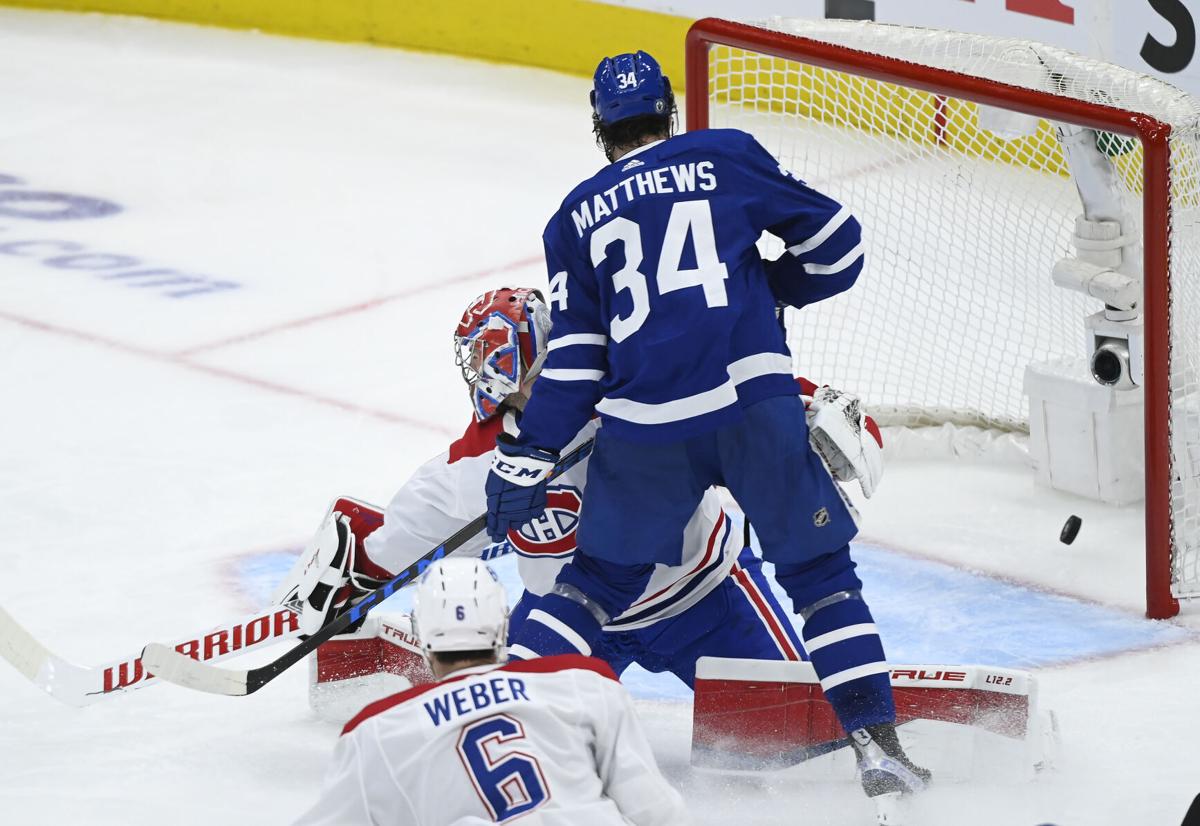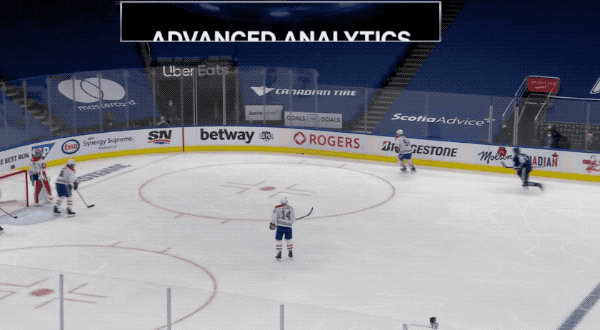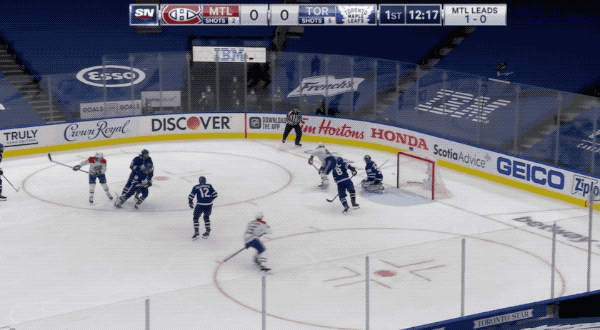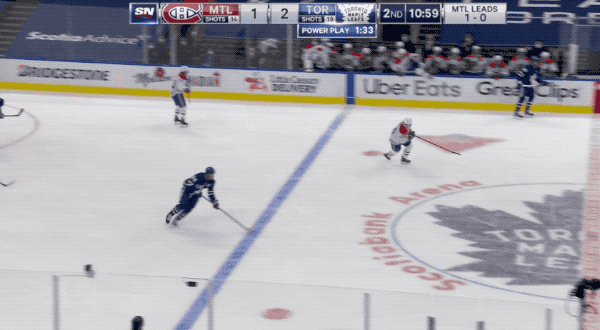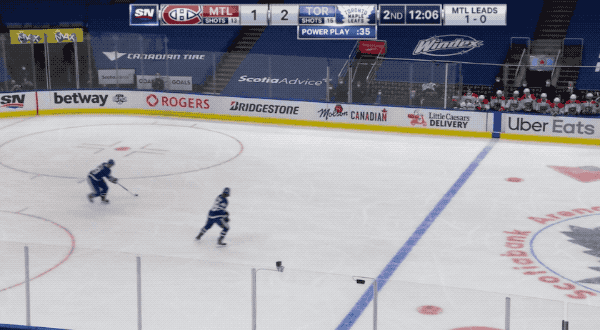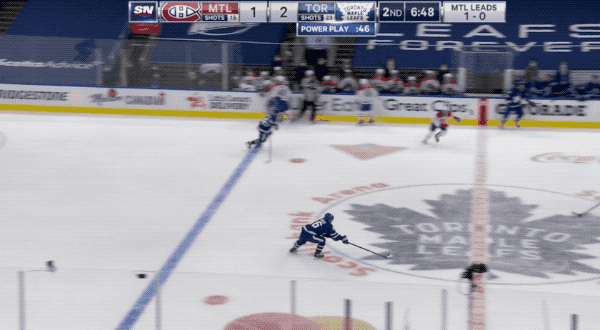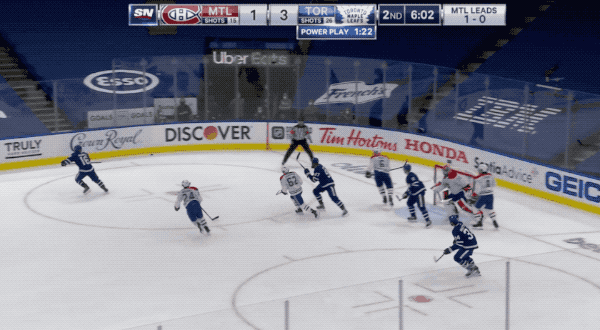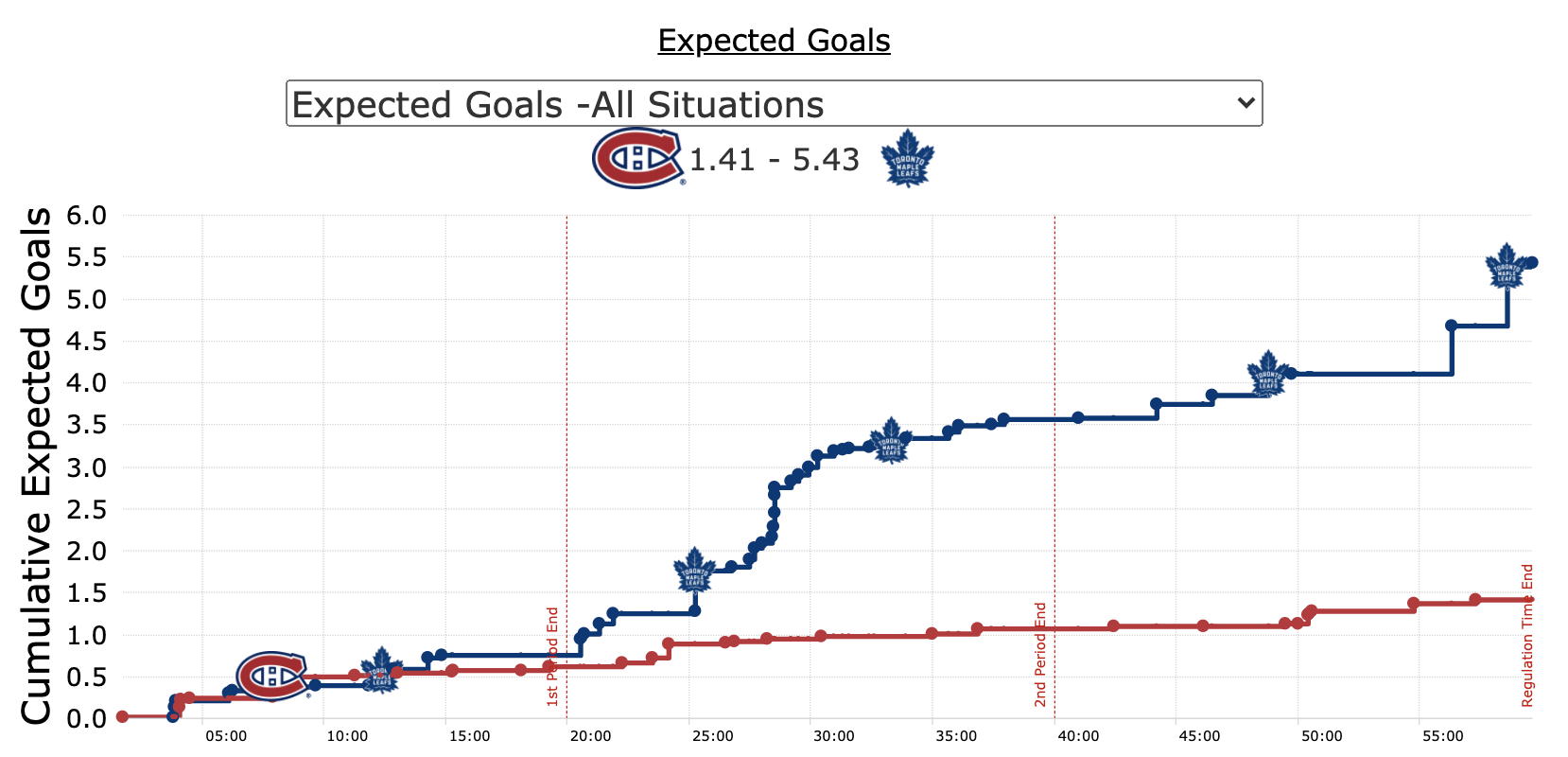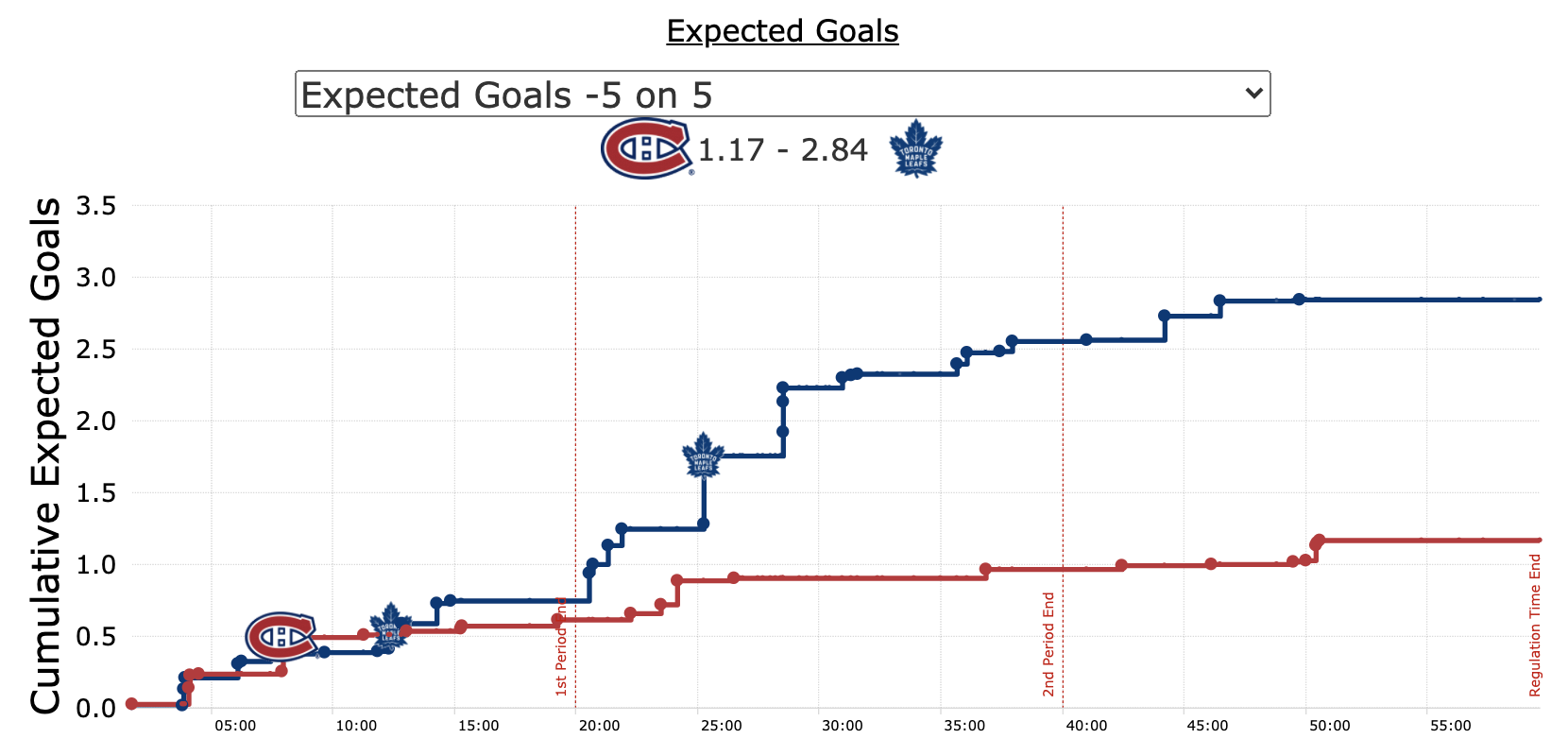The Leafs finally fixed their power play!
You could argue it looked pretty good in Game 1 apart from the shorthanded goal, but the floodgates finally opened for Toronto in Game 2.
We’ll dive deeper into the tactical side of things later in the article, which I can’t wait to break down considering the Leafs scored twice on the power play en route to a 5-1 victory. They also hit two posts at 5v4, completed several seam passes, and actually looked dangerous for long stretches.
It helps when the Canadiens give you free PP practice in the second period by parading to the penalty box time and time again. I’ll never understand why Marc Bergevin & Co. wanted a goaltender interference challenge on a goal that clearly didn’t warrant one, but alas, it gave the Leafs‘ power play another opportunity to finally get things clicking.
There’s so much fun stuff to dive into with this game, especially considering the emotional aftermath of the John Tavares injury in Game 1. I can honestly say I haven’t been able to get that image out of my head, although a Rasmus Sandin bomb on PP1 certainly lifted my spirts.
In our attempt to rationally analyze what I’m sure was an emotional night for most Leafs fans, let’s jump into some postgame analysis. We’ll start with the most impactful players.
Noteworthy Performances
The Engvall-Kerfoot-Mikheyev Line
They absolutely dominated play at 5v5, tilting the ice in Toronto’s favour for the majority of their shifts. When Ilya Mikheyev was on the ice, the shot attempts were 16-3 Toronto, scoring chances were 9-1 Toronto, and the team allowed zero expected goals against. That speaks to Mikheyev’s strong defensive game, using his long stick to break up plays and help his team regain puck possession.
Pierre Engvall and Alex Kerfoot were right up there among Leafs‘ best players. Engvall, in particular, was doing all of the little things that Sheldon Keefe has been begging him to do all season: Going hard into puck battles, using his size to push opponents off the puck, really taking advantage of his unique size/speed combo.
For example, this is my favourite shift of Engvall’s NHL career.
He gets a body on the first man, then knocks down Shea Weber with a clean hit, who proceeds to get mad and take a frustration penalty on Engvall.
It’s worth pointing out that Engvall also positively impacted play by transporting the puck from DZ to OZ with his speed and using his heavy shot off the rush on multiple occasions, but it’s going outside of his comfort zone with extra physicality that really impressed me. In the playoffs, you need your players who typically avoid contact to be embracing it if you’re going to come out of the corners with the puck. Engvall really answered the bell in that department while providing significantly more offense than a Riley Nash ever could have.
With Kerfoot, he provided big-time value on the PK by blocking a few shots and using his speed to close the gap on opposing puck carriers. At 5v5, he and Engvall both did a great job of carrying the puck through the neutral zone with speed, an area where Toronto really struggled in Game 1.
After getting into the offensive zone, the entire third line did a great job of applying pressure on the forecheck to keep Montreal hemmed in their own zone. At one point they were even able to get a line change while cycling in the offensive zone, which is how Jason Spezza found himself so open off the bench for his goal.
The Foligno-Nylander “Pair”
I say pair because it’s clear Nick Foligno is the one meant to handle more of the defensive responsibilities on Toronto’s second line, while William Nylander is the primary puck carrier and offensive driver. That dynamic seemed to mostly work out for them on Saturday night, out-chancing Montreal in the minutes they shared at 5v5.
There is one major exception that Kevin Bieksa mentioned on the broadcast. I’ll post the GIF here so you can watch (and re-watch) the following sequence. Keep an eye on Nylander (#88) and Foligno (#71), knowing that eventually, you want the defensively superior forward to be the one lower in the defensive zone.
There appears to be a miscommunication here between Nylander and Foligno. The play starts with Nylander low in the zone, which is going to happen sometimes after defending a rush. I think Foligno expected Nylander to “switch” with him after the puck moved up high, whereas Nylander thought the right move was to stay low and not give up anything from the slot.
What’s funny about micro-analyzing goals against in hockey is that most of it can be boiled down to “they got a bounce” — which is really what happened here — but the communication between Nylander and Foligno will be important moving forward. If you’ve ever watched basketball, elite defensive players like Draymond Green will get really upset when their teammate doesn’t “switch” at the right time.
Is that what happened here? Yes. Is it the reason the puck went in? Probably not, so just keep that in mind the next time your uncle screams about Nylander. If anything, the most culpable player on that goal against is Justin Holl for failing to tie up his man in front, an aspect of his game that’s cost the Leafs in the past.
It’s also worth noting that Alex Galchenyuk didn’t accomplish much at second-line left wing, failing to register a shot attempt. Compare that to the four shots Foligno generated from the slot at 5v5 and the three scoring chances Nylander got off. It was a bit of a two-man show.
Auston Matthews
He did not fail to register a shot attempt. In fact, he generated 10 attempts at the net, converting on one of them while also picking up two assists. We’re going to do a bigger section on the power play shortly, but the main reason PP1 was so effective is because Matthews was making high-end plays that his opponents couldn’t stop.
He’s obviously the team’s biggest shot threat with the man advantage, teeing up multiple one-timers on his off wing. Matthews hit the post twice off of shots from the right dot, the second of which led to a William Nylander power-play goal.
Another thing to keep an eye on is just how often Matthews is transitioning the puck himself, particularly on the power play. He was using his puck-skills to gain the zone at 5v4 before Montreal’s PK had a chance to get set on regroups, which resulted in a few high-percentage rush opportunities.
More on that later.
Other Guys I Liked
I couldn’t quite find the right attributes to group these players together, so let’s just say I enjoyed their play in Game 2. Zach Bogosian made a few great plays offensively, forechecking like a forward on the Spezza goal and then joining the rush on his next shift. He has an affinity for jumping up in the play when the situation calls for it, making good judgement calls on both occasions.
Jake Muzzin is another player I wanted to acknowledge for providing surprisingly strong value offensively as a shot threat, unloading his slap shot from distance a few times as the trailer off the rush. He’s also the player Toronto trusts most as their last man back defensively, especially on the PK, where he was breaking up plays with his stick and using his physicality to clear the front of the net.
Last but not least, Jack Campbell stopped everything except for a rebound goal that ricocheted a few different times before crossing the goal line. We love a good “goaltending controversy” at this time of year, but the fact of the matter is that Campbell has played well for Toronto all season.
Now, the environment for save percentage has improved substantially this season when you look at data from places such as Clear Site Analytics, to the point that I think a lot of NHL-calibre goalies could succeed in this situation. Does that mean I’d give Frederik Andersen the net at some point in this series? Not unless Campbell completely loses his confidence, which doesn’t appear to be the case right now.
The Video Room
I asked Leafs fans after the game why they thought Toronto’s power play was more effective. The general response was “quicker puck movement”, which always sounds good, but how exactly did the Leafs achieve that in Game 2?
One of the biggest things I noticed from re-watching their power plays was how often they looked to attack right off the entry, creating chances off the rush instead of setting up in formation.
A lot of hockey comes down to getting your best players the puck in good spots. Matthews gains the zone here, then Marner ends up with the puck off a quick little drop pass from Zach Hyman. From there, Marner and Matthews run a gorgeous give-and-go that easily could have resulted in a goal.
That rush chance was a sign of things to come. Even PP2 was getting in on the fun.
Spezza is so good on power play entries, reversing play to the weak-side after crossing the blue line, which gets Kerfoot in a ton of open ice for the scoring chance.
Then there’s obviously the 5v4 rush chance you all remember.
When you make quick passes like this after gaining the zone, it puts the defense in a really tough spot. You need high-end skill to pull off the plays in traffic that #16 and #34 do in the clip above, which is why NHL GMs are willing to pay so much money for it (some more than others).
It’s also nice having a shot threat from the top there, which brings us to our next section.
The Power Play
Let’s face it, this is all anyone actually cares about right now. Even without Tavares, we know the Leafs have the ability to play excellent 200-foot hockey at 5v5 this year, which still feels weird to type out. The issue has been their play at 5v4 for the last couple of months, which again feels so strange to actually say about this Toronto team.
Breaking down the game tape, my biggest takeaway was how quickly the Marner-Sandin-Matthews trio were able to move the puck along the perimeter. Sandin walking the line with confidence definitely helped open up some passing lanes, although they didn’t really have anyone to pass it to in the middle of the ice, with Joe Thornton and Zach Hyman both driving towards the net most of the time.
I’m not sure if that’s a winning recipe moving forward, especially the Thornton part. He did help alleviate some of the pressure on Marner by getting himself open on the left wall when that was needed.
This was a nice way of resetting things when the seam pass Marner wanted wasn’t there.
The bigger issue for me is the lack of legitimate shooters on PP1. It was cool to see Nylander and Spezza make some things happen on PP2 together, but I can’t help but think they’d be providing more value if they got more 5v4 time with the team’s best players. That’s how Nylander scored his goal.
“You’re being too negative, the power play looked awesome!”
Maybe I should be a bit more positive here. The Sandin addition to the top unit has given Toronto’s power play some quicker click-click passing when they get set-up, and I really like the way he quickly gets the puck going up the ice on breakouts, often looking to get #34 into open ice.
At the end of the day, my goal here is to analyze what happened on the ice, why it happened, and how the team can improve. Frankly, I don’t think that’s with Thornton in the bumper spot on PP1, even if he is retreating to the boards on occasion to keep things in motion on the perimeter.
That’s one final thing I wanted to bring up. There was motion in the offensive zone at 5v4. Instead of standing in the exact same spot, the skilled players on the outside were moving around with regularity to get themselves open. Now, that was made easier by recovering offensive rebounds and catching the penalty killers out of position, but that’s why you have a Hyman out there; for puck retrievals.
The Numbers
Who doesn’t love some good old-fashioned charts from our friends at MoneyPuck.com to prove how well their favourite hockey team played?
“Well sure, when they gift-wrap you a bunch of power plays.”
“Oh…I see.”
The Leafs controlled the run of shots, scoring chances, and yes, expected goals in this game. It was the case at 5v5 and on the power play. They deserved to win Game 2; if you simulated the game 1000 times based on the shot locations, Toronto would’ve won 90% of the time according to the Deserve-To-Win-O’Meter.
For a quick breakdown of things at the player level, here’s my favourite table to share after every game.
I’ve always found Dom Luszczyszyn’s Game Score to be a solid metric for single-game performance. It doesn’t always match up with the eye test, but that’s why you balance the quantitative with the qualitative analysis.
Tweets of the Night
I’ve been “lurking” on Hockey Twitter this year instead of getting myself super involved in the day-to-day discourse, which may or may not be the right way to use the internet. Either way, it’s given me a chance to keep up to date on what some of my favourite hockey analysts are saying throughout the game.
Here are a few standouts from Saturday night.
Leafs adjusted to the Canadiens trying to constantly stretch the ice in the neutral zone and pounded them into the ground from about midway through the first period. Could be a good thing if the Habs are forced to play their good players more now.
— Andrew Berkshire (@AndrewBerkshire) May 23, 2021
The Leafs were able to capitalize on a few of Montreal’s failed stretch passes, leading to some high-value plays the other way.
Give the Leafs power play percentage is 20%, a challenge makes sense if you think there's >20% odds of it being called back.
— MoneyPuck.com (@MoneyPuckdotcom) May 23, 2021
Based on his performance since taking over for Claude Julien, I’d say there’s a 0% chance Dominique Ducharme has done a good job running this Habs team.
Hear me out:
Bogosian-Matthews-Marner
— Kevin Papetti (@KPapetti) May 22, 2021
Whatever it takes to get my boy Travis Dermott in the lineup.
*Sheds a single tear knowing future Seattle Kraken defenseman Travis Dermott won’t be getting in a playoff game unless there’s an injury*
Stop it they had an emotional set back, you will see a different game tonight.
— Marietta Dubas (@grammadubie) May 22, 2021
Grandma Dubas will not allow “loser energy” in this public forum. It’s a good thing I don’t tweet much anymore. Otherwise, I’d probably be the victim of a vicious dunk like this.
Final Thought
I mentioned this earlier, but I’m still not fully over all the emotions I went through after watching Tavares struggle to get up the other night. The people who have been spending every day with him for the last few months must be feeling similar, if not worse, which is what made Toronto’s response in Game 2 such a big deal for me.
It’s one thing to get a bit of puck luck, ride a hot goalie, and steal a game against a rival. It’s another to completely dominate them in all facets of the game. The latter is what we saw in Game 2 from Toronto. You have to think Montreal is going to put together a better performance in Game 3, especially if they decide to play a few more of their talented young players.
This series just got a lot more interesting. I can’t wait to be along with you all for the ride!























